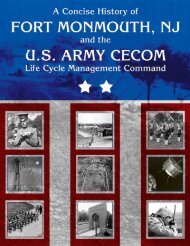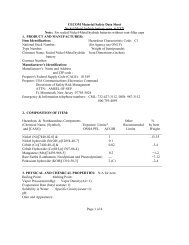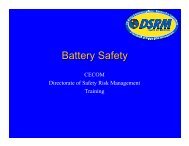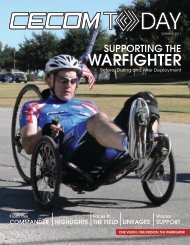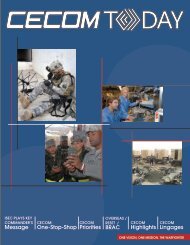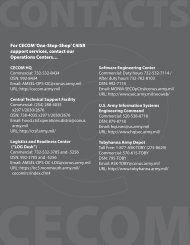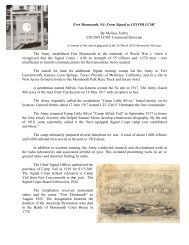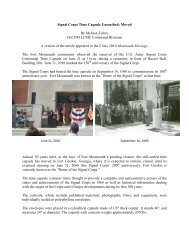Lithium Ion Battery with Cobalt - CECOM
Lithium Ion Battery with Cobalt - CECOM
Lithium Ion Battery with Cobalt - CECOM
Create successful ePaper yourself
Turn your PDF publications into a flip-book with our unique Google optimized e-Paper software.
<strong>CECOM</strong> Material Safety Data Sheet<br />
<strong>Lithium</strong>-ion battery, para. 4-XXX<br />
Note: For sealed <strong>Lithium</strong>-ion batteries <strong>with</strong>out vent-filler caps<br />
1. PRODUCT AND MANUFACTURER:<br />
Item Identification:<br />
Hazardous Characteristic Code: C1<br />
National Stock Number:<br />
(for Agency use ONLY)<br />
Type Number:<br />
Weight of Item(pounds):<br />
Common Name: Sealed <strong>Lithium</strong>-ion (Li-ion) Item Dimensions (inches):<br />
battery<br />
Contract Number:<br />
Manufacturer's Identification:<br />
Manufacturer’s Name and Address<br />
and ZIP code :<br />
Preparer's Federal Supply Code (CAGE): 81349<br />
Preparer: USA Communications-Electronics Command<br />
Directorate of Safety Risk Management<br />
ATTN: AMSEL-SF-SEP<br />
Ft. Monmouth, New Jersey 07703-5024<br />
Emergency & Information telephone numbers: CML: 732-427-3112, DSN: 987-3112<br />
800-793-4093<br />
2. COMPOSITION OF ITEM:<br />
Hazardous & Nonhazardous Components Other %<br />
(Chemical Name, (Symbol), Exposure Limits* Recommended by Item<br />
and [CAS#]) OSHA PEL ACGIH Limits Weight<br />
__________________________________________________________________________________<br />
<strong>Lithium</strong> cobaltite (LiCoO 2 )[12190-79-3] --- ∼10-30<br />
<strong>Lithium</strong> hexaflurorphosphate (LiPF 6 )[21324-40-3] --- ~1-5<br />
Carbon (C)[7440-44-0] 2 ∼10-30<br />
Diethyl Carbonate(C 5 H 10 O 3 )[105-58-8], --- ~5-17<br />
Ethylene Carbonate(C 3 H 4 O 3 )[96-49-1], and ---<br />
Propylene Carbonate(C 4 H 6 O 3 )[108-32-7] ---<br />
Aluminum (Al)[7429-90-5] 2
4. STABILITY AND REACTIVITY:<br />
Chemical Stability: Stable: X Unstable:<br />
Conditions to avoid: DO NOT: • Expose to fire or excessive heat, or overcharge.<br />
• Abuse, mutilate or short circuit the battery.<br />
Incompatibility:<br />
Store in separate stacks from hazardous materials.<br />
Hazardous Decomposition Products: When exposed to extreme heat/fire batteries may rupture<br />
leaking corrosive material and/or emit toxic fumes. Burning batteries may emit acrid smoke irritating<br />
fumes, and toxic fumes of fluoride.<br />
Hazardous Polymerization: May Occur:<br />
Conditions to avoid:<br />
Will not Occur: X<br />
5. HEALTH HAZARD IDENTIFICATION:<br />
Emergency Overview (including Signs and Symptoms, Route(s) of Entry, etc.)<br />
Intact batteries present no specific hazards.<br />
Acute Health Hazards (e.g., Inhalation, Eye Contact, Skin Contact, Ingestion, etc.):<br />
Burning batteries: AVOID inhalation of toxic fumes. Burning batteries emit toxic fumes, which are<br />
irritating to the lungs.<br />
Leaking batteries: AVOID exposure to leaking electrolyte, it can cause severe irritation and/or damage<br />
to the skin, mucous membrane or eyes.<br />
Chronic Health Effects (e.g., Carcinogenicity, Teratology, Reproduction, Mutagenicity, etc.):<br />
<strong>Cobalt</strong>: Suspected human carcinogenic agent.<br />
Medical Conditions Generally Aggravated by Exposure: None.<br />
6. FIRST AID MEASURES:<br />
Inhalation: If battery is burning, leave the area immediately. If exposed to fumes, seek medical<br />
attention promptly.<br />
Skin Contact: If battery electrolyte leaks on to the skin flush the affected area for at least 15 minutes<br />
<strong>with</strong> clean water. DO NOT attempt to neutralize. Seek medical attention promptly.<br />
Page 2 of 4
7. FIRE FIGHTING and EXPLOSION HAZARD DATA:<br />
Flammable Properties: N/A<br />
Flashpoint: Method:<br />
Autoignition Temperature:<br />
Flammable Limits: N/A<br />
Lower flammable limit: Upper flammable limit:<br />
Hazardous Combustion Products: Burning batteries may emit acrid smoke irritating fumes, and toxic<br />
fumes of fluoride.<br />
Extinguishing Media: Carbon dioxide (CO 2 ) or dry chemical fire extinguisher, 10-B:C.<br />
Fire Fighting Instructions:<br />
Personnel: Fight the fire in a defensive mode, while exiting the area. When using a CO 2 fire<br />
extinguisher, DO NOT re-enter the area until it has been thoroughly ventilated (i.e., purged) of the CO 2<br />
extinguishing agent.<br />
Firefighters: Use a self-contained breathing apparatus (SCBA).<br />
8. ACCIDENTAL RELEASE MEASURES:<br />
Small Spill: If batteries show signs of leaking, AVOID skin or eye contact <strong>with</strong> the material leaking<br />
from the battery. Use chemical resistant rubber gloves and non-flammable absorbent materials for<br />
clean-up. Coordinate disposition <strong>with</strong> the Installation Environmental Office.<br />
9. HANDLING AND STORAGE:<br />
Handling: Recharge batteries IAW methods specified in applicable technical manuals.<br />
DO NOT: • Overcharge this battery.<br />
• Abuse, mutilate or short circuit the battery.<br />
Storage: Gain approval for storage areas from the Installation Fire Department. Store batteries in a cool<br />
(i.e.,
10. EXPOSURE CONTROL/PERSONAL PROTECTION EQUIPMENT:<br />
Engineering Controls:<br />
General Exhaust: Local Exhaust:<br />
Special: If the battery is damaged and leaking, protect hands <strong>with</strong> chemical resistant rubber gloves.<br />
If the battery is burning, leave the area immediately.<br />
Protective Equipment :<br />
Respiratory Protection: During fire fighting firemen should use SCBA.<br />
Skin Protection: Use chemical resistant rubber gloves, when cleaning-up leaking batteries.<br />
11. DISPOSAL CONSIDERATIONS/ECOLOGICAL INFORMATION:<br />
Waste Disposal Method: DO NOT incinerate<br />
1. Li-ion batteries are nonhazardous solid waste (NHSW) under Resource Conservation and Recovery<br />
Act (RCRA) regulations. ???????. All batteries will be managed IAW equipment TM requirements,<br />
and disposal will be IAW requirements under the Universal Waste Rule (USEPA), state and local<br />
regulations.<br />
2. These batteries should be recycled, if possible. Coordinate battery disposition and disposal <strong>with</strong> the<br />
Installation Environmental Office and the servicing Defense Reutilization and Marketing Office.<br />
12. TRANSPORTATION INFORMATION: Li-ion batteries are not regulated under the federal<br />
hazardous materials provisions of 49 Code of Federal Regulations (CFR) part 172.101.<br />
Procedures: Securely package batteries to <strong>with</strong>stand conditions normal to shipping. Protect batteries<br />
against short circuiting.<br />
Special Precautions: Isolate and remove damaged and/or leaking batteries, if possible. Notify local<br />
health, safety and environmental agencies.<br />
Page 4 of 4



